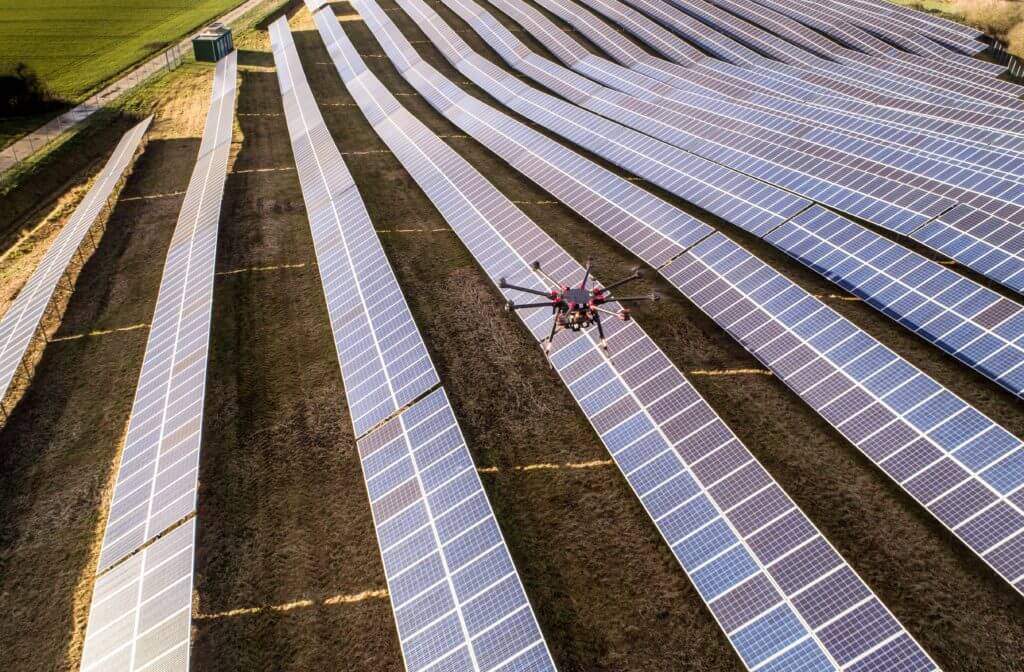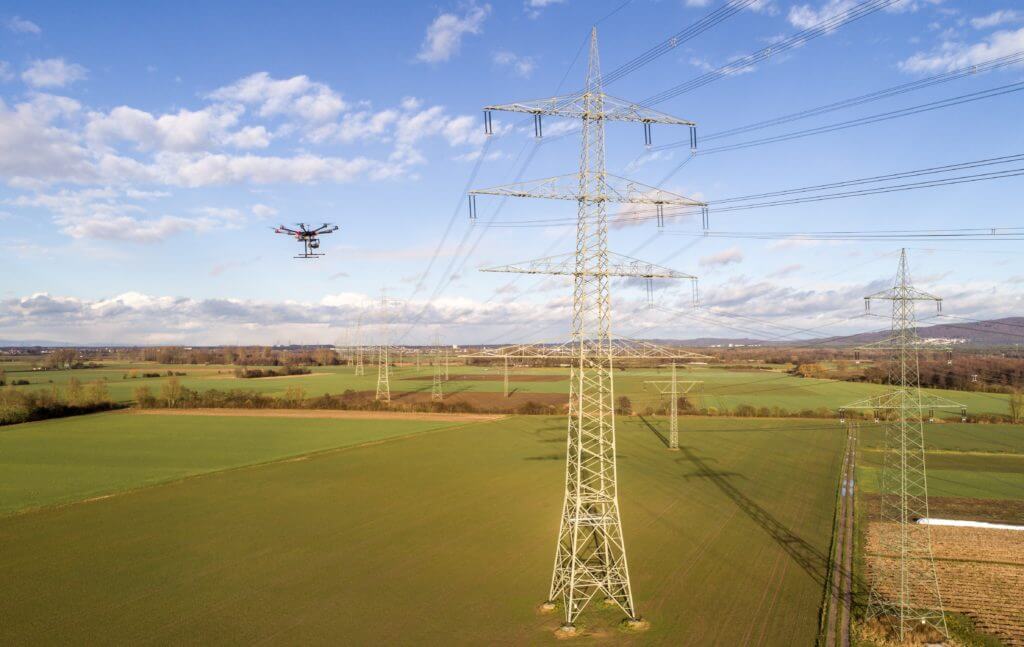Our UAV services in the energy industry and the inspection of energy systems at a glance:
Visual condition recording and damage recording using UAVs
- High-resolution aerial images for inspecting and documenting actual conditions and for the visualisation of damage in the energy industry
- High-resolution videos from the air for inspecting and documenting actual conditions and for the visualisation of damage to power lines, wind turbines and PV systems
- Live HD image transmission for the inspection of power lines, wind turbines and PV systems in real-time
- Regular inspection of heavily loaded energy systems, such as drilling rigs, offshore wind farms, dams in rock mass
- Thermal inspection of energy systems, power lines and district heating pipelines using UAVs and radiometric thermal imaging cameras
Inspection of wind turbines
- High-resolution aerial images for inspecting and documenting actual conditions and for the visualisation of damage; e.g. lightning strikes
- Live HD image transmission for direct inspection and analysis by engineers or servicing personnel on the ground in real-time
- Inspection, documentation and repair of wind turbines from one source
Checking and inspecting photovoltaic systems using thermography
- PV system inspection based on thermographic images and high-resolution aerial images and videos
- Regular inspection and evaluation of photovoltaic systems
- Certified evaluation report for result documentation
Inspection of energy systems using UAVs (Unmanned Aerial Vehicle)
Inspection of energy systems, such as wind turbines and photovoltaic systems
In the energy industry, it is mostly cost-intensive to obtain data from tall, difficult-to-access energy systems, such as wind turbines and buildings. It is for this reason that we opt for UAV (drone) inspections, in order to be able to gather condition information efficiently and with low levels of risk from the air. Large-scale systems, such as photovoltaic systems, can be examined quickly without stoppages using UAVs.
By means of our sensor systems, such as radiometric thermal cameras (thermography), high-resolution photo/video cameras and laser scanners, we supply pinpoint, digital aerial images which are available for inspection in various data formats. Using the data and images, damage points such as cracks (even hairline cracks), delamination, lightning strikes, thermal loss, thermal bridges, corrosion, erosion, assembly faults or deformation can be visually detected and documented.
Our experienced pilots and experts in the fields of inspection and thermography support you with your project planning and advise you extensively concerning the application options of UAVs and their sensors and take on the work of data evaluation. Data evaluation by the customer is also possible. In such cases, we would provide you with the raw data.

Applications in the field of energy systems at a glance:
- Wind turbines
- Photovoltaic systems
- Power plants
- Biogas plants
- High-voltage and power lines
- Power electronics
- District heating pipelines (overhead and below the ground)
- Insulation and thermal bridges
- Chimneys and flues
Inspection of wind turbines
Wind turbines can be inspected in an efficient and, above all, low-risk manner using UAVS, because difficult-to-access regions are often best approached from the air. By inspecting with a drone up close and personal, damage or alterations can be analysed in detail, and downtimes from stoppages can be minimised. The images or 3D data are made available to your engineers, technicians and/or repair team immediately, appropriate measures can thus be taken in good time. We also offer the option of live HD image transmission with which you can conduct inspections in real-time. This way the technician can have the drone directed to centimetre-precision through our professional pilots or have the camera controlled. Critical points can thus be approached and assessed from various viewing angles. Defects and damage can be localised optimally using images and repaired quickly in targeted fashion.
Inspection, documentation and repair of wind turbines from one source
Our partners at Hochseilwerk take control for difficult-to-access points of complex structures, especially wind turbines. Their professional service is focussed on manual inspection as well as the subsequent repair, cleaning and maintenance of wind turbines.
 Hochseilwerk GbR
Hochseilwerk GbR
Am Markstein 5a
64673 Zwingenberg
Phone: + 49 (0) 69 173 208 940
E-Mail: hochseilwerk@gmail.com
Internet: www.hochseilwerk.de
Thermal inspection of energy systems
UAV (Drone)-supported thermal inspections of energy systems is an effective solution for inspecting difficult-to-access areas and for documenting damage spots. Damage, leaks and thermal loss which are difficult for the human eye to see can be detected with ease by means of radiometric thermal imaging cameras. We provide thermographic evaluation of the data, as well as the pure gathering of the raw data for evaluation by the customer.
Live HD image transmission for the inspection of energy systems in real-time
We offer the option of live HD image transmission for inspections in real-time on the ground using a monitor. This way an engineer can have the drone directed to centimetre-precision through our professional pilots or have the camera controlled. Critical points can thus be approached and assessed from various viewing angles. Actual conditions, defects and damage can be localised optimally using images and repaired quickly in targeted fashion. Furthermore, the recording of images for documentation is possible permanently or partially. 
High-resolution aerial images for documenting actual conditions of energy systems
Our high-resolution aerial images, taken using our UAVs, are ideal for the analysis and documentation of damage, destruction and insurance cases. Through discussions held in advance, we can narrow down the exact type of pictures you require for documentation purposes – different angles, flight altitudes and precisely reproduced flights (GPS-supported) for multiple or later points in time pose no problem at all. We fly outdoors, but also in enclosed spaces, power stations, tunnels, towers and pipelines. Only high-end cameras are used, with or without zoom lenses.
High-resolution videos from the air for documenting actual conditions and for visualisation
With detail-rich moving images from the air, the latest incidents, accidents and damage can be optimally depicted and can be presented in the simplest way. For this reason, we supply you with high-resolution video material (Full HD – 4K) and images with SLR camera quality (24MP) from the air. The transmission of live images poses no problem at all, and in acute cases is actually very helpful in evaluating situations on site so that appropriate damage-limitation measures can be taken.
Checking and inspecting photovoltaic systems using thermography
The inspecting of photovoltaic systems (or PV systems for short) is usually a very complex task, but one which can be done much more quickly, more safely and above all contact-free with the help of drones. thermographic data of a photovoltaic system can be recorded from the air with our radiometric camera and evaluated without personnel being in difficult-to-access areas or being subjected to significant danger. Damage and negative abnormalities are analysed and accurately documented so they can subsequently be resolved. Contact-free, thermographic inspections of photovoltaic systems are performed during live operations with no stoppages as a result.
Lodge photovoltaic system warranty claims in good time!
It is highly recommended, especially in the case of medium-to-large-sized facilities, to subject the photovoltaic system (PV system) to a thermographic inspection after commissioning but before the expiry of the warranty at the latest, in order to lodge warranty claims with the manufacturer of installer. Defective modules, module failure (even partial failure), cell breakage, defective strings, assembly errors (incorrect cabling) and penetrated moisture are hardly rarities and lead to reduced yields in therms of electricity production, because the system cannot deliver the desired power. This can sometimes reduce the profitability of a photovoltaic system significantly.
Most photovoltaic systems can be optimised!
We recommend an initial inspection immediately after the commissioning of the photovoltaic system. The data derived from this is not only used for lodging possible warranty claims; it is also used as a reference value for later evaluations. Furthermore, it makes sense to perform a thermographic inspection and an optical inspection using a UAV regularly (every 1–2 years). By means of our highly sensitive and high-resolution radiometric cameras on our multicopter, we can identify even the slightest abnormalities, damage or soiling on individual modules. We check and analyse private photovoltaic systems on house roofs all the way up to industrial plants.
Certified evaluation report for result documentation
We evaluate the recorded radiometric data from aerial thermography in combination with the images from high-resolution photo or video cameras and deliver a comprehensive and certified evaluation report in the form of a PDF document, including site plan, so that damage and problems can subsequently be resolved efficiently.
You can find the various drone services HERE
We would be delighted to provide you with a tailored and non-binding offer. Please feel free to use our PROJECT QUERY page to submit a query.